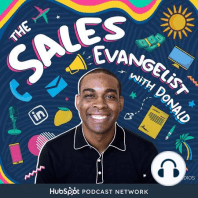8 min listen

TSE 1168: Selling In Europe Vs. Selling In The USA
TSE 1168: Selling In Europe Vs. Selling In The USA
ratings:
Length:
31 minutes
Released:
Aug 27, 2019
Format:
Podcast episode
Description
Every sales transaction differs from the others, but when you're selling in Europe vs. selling in the USA, it's important to understand the differences in culture. Christine Schlonski works with entrepreneurs who have a negative view of sales. She helps them redefine their view of it so they can sell with ease, grace, and confidence and also ask their price. In short, she helps them makes sales, which is simply an interaction between people, fun. Fear of selling Christine points to the depiction of sales in movies, coupled with bad sales experiences that we’ve all had. Subconsciously, we don’t want to be like these people. Women especially struggle to ask for what they truly want because it feels salesy or pushy. They often assume because they’re good people that buyers will line up to buy. It’s possible to ask for the sale in a natural way but movies never depict sellers in a positive light. It’s likely that a movie about a seller who sells from the heart and brings value would be boring. But sales truly could be like that. Set the expectation and then make the offer. Then consider what’s a go and what’s a no-go. How can we work together? Sales differences Sales in the U.S. move quickly, while people in Europe like time. Realize, too, that Europe isn’t a single country, and sales differ across those countries. In France, for example, sales involves numerous decision-makers, and French people love meetings. Where Americans look to make things happen, you cannot simply show up with an offer and a take-it-or-leave-it attitude. Germans exist between those two extremes because they want to be a bit more efficient. Still, though, they cannot be pushed or pressured into decisions. Relationships are still the key to all sales. The decision-maker needs to feel comfortable in the relationship and feel as though he is making a good decision. Typically, larger companies have more complicated decision making processes. They often have male leaders and sometimes one of them will block the process because of politics or a need to be right. Selling in Europe will never be a one-call close. Unique preferences Christine had experiences in the past where her work with a global company selling high-ticket events over the phone was negatively affected by her American colleagues who were perceived as being pushy. The prospects assumed that her sales process would operate the same way, so they weren’t interested. For companies who operate in different countries, training sellers to understand the cultural differences can present a challenge. Begin with the simple understanding that no two people are alike. Even without the cultural differences, there’s no one-size-fits-all solution because we’re all human with unique preferences. Consider yourself as an example. How would you want to be treated during a call? What’s important to you? Then, be open to cultural differences and be aware of misunderstandings, but understand that it isn’t a case of the prospect not liking you. In Christine’s case, she learned to operate as though any “no” in the process was always her fault because she hadn’t managed some part of the process correctly. She understands, too, that if she calls into the U.S. she needs to operate with the correct urgency, because it’s what they expect. Small talk Sellers in the U.S. are pretty good with small talk, but in the U.K., for example, talk about the weather can be important. Some people perceive that as a waste of time, but you must adjust to the person you’re speaking to. Adjusting the conversation to your audience doesn’t demand that you be fake. Pick something that’s meaningful to you that will bring the other person into the conversation as well. Suspend your own thinking toward the customers’ needs. Accommodate them. In the U.S., for example, people don’t give a true answer to the question, “How are you?” Instead, they’ll say, “I’m fine.” In other countries, they’ll be more likely to answer honestly. Approac
Released:
Aug 27, 2019
Format:
Podcast episode
Titles in the series (100)
TSE 000: Welcome to the Sales Evangelist Podcast! by The Sales Evangelist